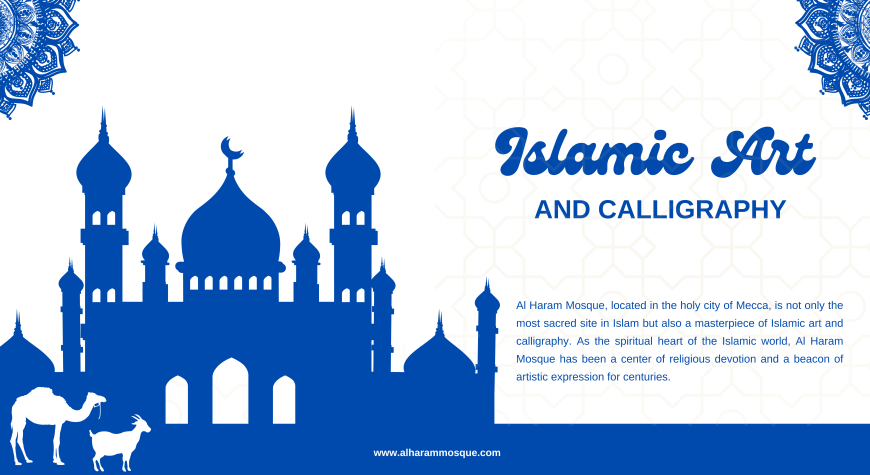Islamic Art and Calligraphy in Al Haram Mosque

A Journey Through Time and Beauty:
Al Haram Mosque, located in the holy city of Mecca, is not only the most sacred site in Islam but also a masterpiece of Islamic art and calligraphy. As the spiritual heart of the Islamic world, Al Haram Mosque has been a center of religious devotion and a beacon of artistic expression for centuries. This blog explores the intricate and awe-inspiring art and calligraphy that adorn this magnificent mosque.
The Spiritual Significance of Al Haram Mosque:
Before delving into the artistic aspects, it’s essential to understand the profound spiritual significance of Al Haram Mosque. It is home to the Kaaba, the qibla (direction) towards which Muslims around the world pray. The mosque holds immense religious importance, hosting millions of pilgrims during the annual Hajj and Umrah.
The Evolution of Islamic Art in Al Haram Mosque:
Islamic art in Al Haram Mosque has evolved over centuries, reflecting the diverse influences and styles of different Islamic dynasties. From the early Umayyad caliphs to the Ottoman sultans, each era has contributed to the mosque’s artistic heritage.
Umayyad Contributions :
The earliest significant artistic contributions to Al Haram Mosque were made during the Umayyad period (661-750 CE). The Umayyads were instrumental in expanding and embellishing the mosque, introducing elements of Islamic architecture and calligraphy. The use of geometric patterns, arabesques, and early Arabic calligraphy set the foundation for future artistic endeavors.
Abbasid and Fatimid Enhancements:
The Abbasid (750-1258 CE) and Fatimid (909-1171 CE) dynasties further enriched the mosque’s artistic landscape. The Abbasids introduced intricate stucco work and decorative elements, while the Fatimids brought their distinct style of calligraphy and architectural innovation. This period saw the mosque’s expansion and the addition of elegant minarets.
Mamluk and Ottoman Masterpieces:
The Mamluk (1250-1517 CE) and Ottoman (1299-1922 CE) periods marked the zenith of Islamic art and calligraphy in Al Haram Mosque. The Mamluks were known for their exquisite tile work and monumental inscriptions, while the Ottomans, under Sultan Suleiman the Magnificent, undertook extensive renovations, adding breathtaking calligraphic panels and intricate marble work.
The Art of Calligraphy in Al Haram Mosque:
Calligraphy holds a special place in Islamic art, often referred to as the “art of the written word.” In Al Haram Mosque, calligraphy serves both a decorative and a spiritual function, with verses from the Quran meticulously inscribed on walls, arches, and domes.
Kufic Script:
One of the earliest scripts used in the mosque is Kufic, characterized by its angular and geometric form. Kufic calligraphy can be seen in various parts of the mosque, often used for Quranic inscriptions and architectural embellishments. Its bold and striking appearance adds a sense of grandeur and timelessness to the sacred space.
Thuluth Script:
The Thuluth script, known for its flowing and cursive style, became prominent during the Mamluk and Ottoman periods. This script is widely used in the mosque’s decorative panels, mihrabs (prayer niches), and domes. The elegance of Thuluth calligraphy enhances the spiritual atmosphere, inviting worshippers to contemplate the divine messages.
Naskh Script:
Naskh, a more legible and smaller script, is often used for Quranic manuscripts and smaller inscriptions within the mosque. Its clarity and readability make it ideal for conveying religious texts, ensuring that the divine words are accessible to all who visit this sacred site.
The Beauty of Islamic Geometry and Arabesque:
Islamic art is renowned for its use of geometric patterns and arabesque designs, symbolizing the infinite nature of Allah. In Al Haram Mosque, these patterns adorn walls, ceilings, and floors, creating a harmonious and meditative environment.
Geometric Patterns:
Geometric patterns in the mosque often consist of intricate interlocking shapes, such as stars, hexagons, and octagons. These patterns are meticulously crafted, reflecting the precision and mathematical genius of Islamic artisans. The repetition and symmetry of these designs symbolize unity and the eternal nature of the divine.
Arabesque Motifs:
Arabesque motifs, characterized by flowing and interlacing floral and vegetal designs, are another hallmark of Islamic art in Al Haram Mosque. These motifs are often combined with calligraphy, creating a seamless blend of the written word and ornamental beauty. The arabesques represent the infinite creativity of Allah and the interconnectedness of all creation.
Modern Renovations and Preservation:
In recent times, Al Haram Mosque has undergone significant renovations and expansions to accommodate the growing number of pilgrims. These modern enhancements have been carried out with great care to preserve the mosque’s artistic heritage while incorporating contemporary elements.
State-of-the-Art Facilities :
The addition of state-of-the-art facilities, such as advanced lighting and sound systems, ensures that the mosque continues to serve as a comfortable and spiritually uplifting space for worshippers. Modern materials and techniques have been seamlessly integrated with traditional art and architecture, maintaining the mosque’s timeless beauty.
Preservation Efforts:
Efforts to preserve and restore the mosque’s historical art and calligraphy are ongoing. Skilled artisans and conservation experts work diligently to maintain the integrity of the mosque’s artistic treasures, ensuring that future generations can continue to appreciate and be inspired by this sacred heritage.

